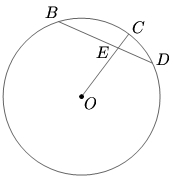Difference between revisions of "1971 Canadian MO Problems"
(→Problem 4) |
Airplanes1 (talk | contribs) |
||
| Line 11: | Line 11: | ||
== Problem 2 == | == Problem 2 == | ||
| − | + | Let <math>x</math> and <math>y</math> be positive real numbers such that <math>x+y=1</math>. Show that <math>\left(1+\frac{1}{x}\right)\left(1+\frac{1}{y}\right)\ge 9</math>. | |
[[1971 Canadian MO Problems/Problem 2 | Solution]] | [[1971 Canadian MO Problems/Problem 2 | Solution]] | ||
| Line 17: | Line 17: | ||
| − | + | <math>ABCD</math> is a quadrilateral with <math>AD=BC</math>. If <math>\angle ADC</math> is greater than <math>\angle BCD</math>, prove that <math>AC>BD</math>. | |
[[1971 Canadian MO Problems/Problem 3 | Solution]] | [[1971 Canadian MO Problems/Problem 3 | Solution]] | ||
Revision as of 21:27, 13 December 2011
This is an empty template page which needs to be filled. You can help us out by finding the needed content and editing it in. Thanks.
Contents
Problem 1
![]() is a chord of a circle such that
is a chord of a circle such that ![]() and
and ![]() Let
Let ![]() be the center of the circle. Join
be the center of the circle. Join ![]() and extend
and extend ![]() to cut the circle at
to cut the circle at ![]() Given
Given ![]() find the radius of the circle
find the radius of the circle
Problem 2
Let ![]() and
and ![]() be positive real numbers such that
be positive real numbers such that ![]() . Show that
. Show that ![]() .
.
Problem 3
![]() is a quadrilateral with
is a quadrilateral with ![]() . If
. If ![]() is greater than
is greater than ![]() , prove that
, prove that ![]() .
.
Problem 4
Determine all real numbers ![]() such that the two polynomials
such that the two polynomials ![]() and
and ![]() have at least one root in common.
have at least one root in common.










